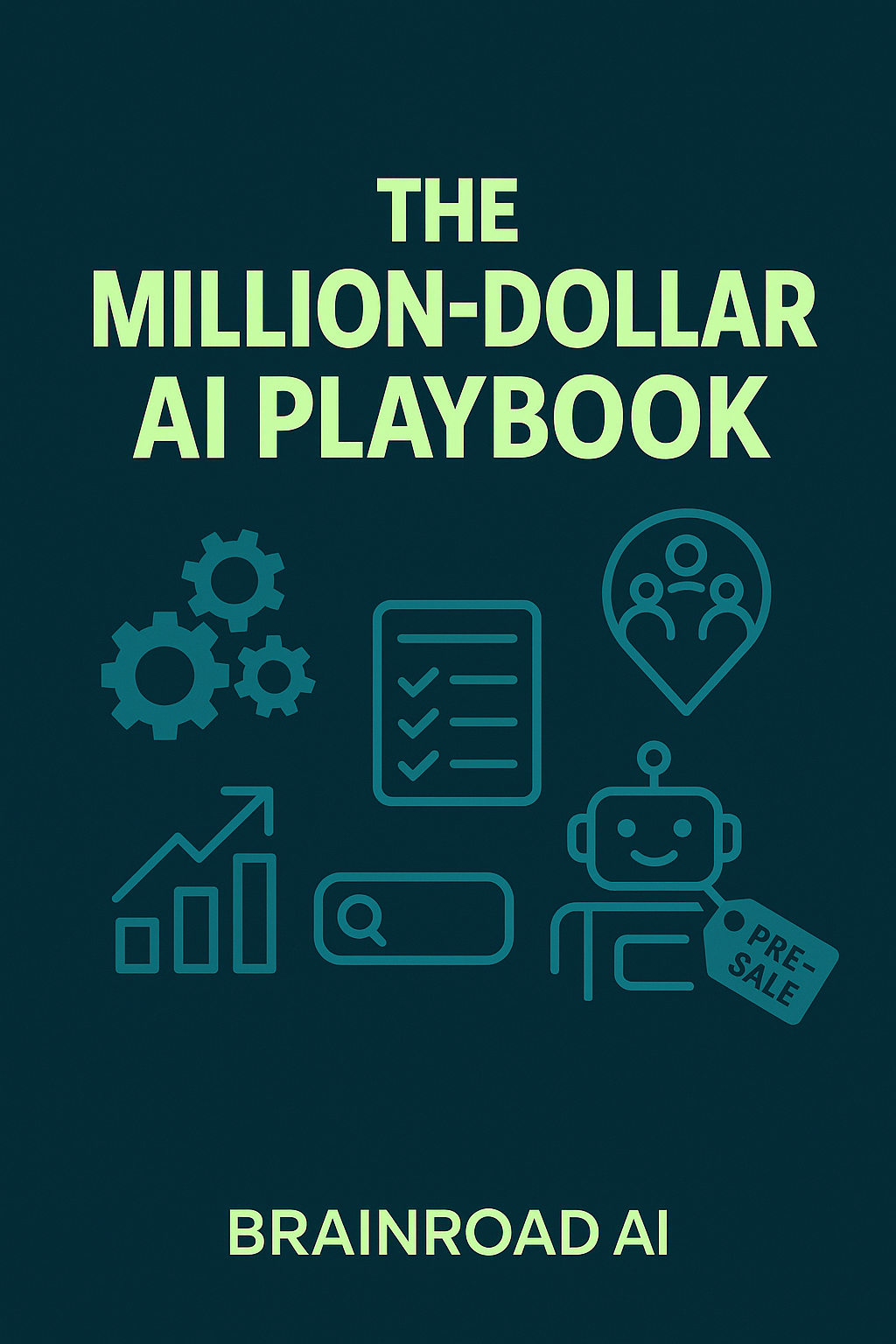Series: AI Money-Making Playbooks
Who it’s for: Solo founders & small teams
Outcome: Launch a validated AI offer + first sales
Time to value: 7 days
Start here: If your goal is to make money with AI this month, the fastest path is acquiring clients → AI Lead Generation hub
In This Playbook (Table of Contents)
- TL;DR: The 5-Step System
- Why “Too Small for VC” is Perfect for You
- Step 1: Ideation (Autocomplete Drill)
- Step 2: Validation (Pre-Sale Test)
- Step 3: Build (Prototype Fast, Harden Later)
- Step 4: Growth (The 5-Channel Engine)
- Step 5: Automate (Design for Default-Run)
- 7-Day Action Plan
- FAQ
- Glossary
- Related Playbooks
TL;DR: The 5-Step System
- Find demand with a 30-minute Google Autocomplete drill + quick keyword checks.
- Validate with a one-screen waitlist and a real pre-sale (60–80% off).
- Build an MVP fast with AI-assisted dev tools; harden later for scale and reliability.
- Grow via a 5-channel engine (Social → SEO, Affiliates, Directories/Forums, Free Tools).
- Automate ops and marketing with agents so the business defaults to “run.”
Evidence (2025-10-06): Pre-selling measures willingness to pay—a stronger signal than clicks or signups.
Why “Too Small for VC” is Perfect for You
VCs chase billion-dollar markets, leaving thousands of profitable low-competition niches unserved. Your edge:
- Target a specific role + industry (e.g., “quoting assistant for independent insurance brokers”).
- Solve one hated workflow completely.
- Cross-sell adjacent micro-tools after your first win.
Tip: Portfolio > single bet. A few simple products drive most revenue; the others act as lead magnets and cross-sell bridges.
Step 1: Ideation (Autocomplete Drill)
A) Scratch-Your-Own-Itch (with constraints)
List 10 workflows you personally hate. For each, ask:
- Would I pay monthly to never do this again?
- Can a machine do 80% acceptably well?
- Is the data accessible via APIs, inbox, or parseable files?
If “yes” to all three, that’s a candidate.
B) The “that/for” Autocomplete Drill (15–30 minutes)
Type patterns like:
AI agent that …AI tool for …website builder for …customer service automation for …
Collect the long-tail suggestions (real queries). Sanity-check your top 20 in a keyword tool for volume + difficulty. Keep ideas with buyer intent and winnable SERPs (weak content, low authority competitors).
Local angle: Combine geo + service + intent. Example: “AI appointment setter for roofers in [city]”.
Step 2: Validation (Pre-Sale Test)
Your job is to kill weak ideas fast.
1) One-Screen Waitlist Page
Use Framer/Webflow/Unicorn Platform. Include:
- Outcome headline (“Cut claim time from 3 hours → 20 minutes”)
- 3 bullets (inputs, output, proof/constraints)
- Email field only (no phone, no survey)
- Privacy note (“No spam. 1–2 updates.”)
2) The Pre-Sale (The Real Test)
- Run 100 manual touches (forums, DMs, small lists). If 0 signups after 100, kill or reposition.
- Email the waitlist with a 60–80% off founding offer to pre-book.
- Target ≥10% conversion from waitlist → paid. Miss it? The problem, audience, or offer isn’t strong enough yet.
Why email, not only a checkout button? Replies reveal pricing/packaging objections you can fix (“one-time vs subscription”, seat counts, export requirements).
Step 3: Build (Prototype Fast, Harden Later)
Prototype Fast; Structure for Production
- Prototype: Cursor / Replit / Lovable / Bolt — finalize UX and flow quickly.
- Production stack: Next.js/Nest (or Rails/Django), Postgres, auth, background jobs, observability.
Separate Concerns for SEO and Speed
- Marketing site/landing pages: Framer/Webflow for speed + SEO (no auth).
- Application: Your framework for auth, billing, data, reliability.
Step 4: Growth (The 5-Channel Engine)
1) Social → SEO Flywheel
Test positioning on social. Good posts trigger mentions, listicles, and backlinks—lifting rankings without manual link-building.
2) Directories, Forums, and Comparison Sites
List your tool where buyers already look (niche directories, Reddit, industry newsletters). This creates structured evidence search engines and assistants can reference.
3) Affiliates (Be Meaningfully Generous)
Set recurring commissions partners actually care about (e.g., 30–40% early if margins allow). Provide swipe copy, sample posts, and a live dashboard. Pay on time.
4) SEO from Day One
Publish how-to guides, checklists, and tiny free tools that target your Autocomplete long-tails. Revisit monthly: double down on URLs that move; prune/refresh the rest.
5) Free Lead Magnets That Help Right Now
Build a tiny tool your exact buyer needs this week:
- Artists → Album-cover generator / portfolio audit checker
- Realtors → Listing-description writer / open-house SMS pack
- Contractors → Estimate formatter / scope-of-work generator
Gate high-res downloads via email; follow with a short sequence that naturally introduces the paid product.
Step 5: Automate (Design for Default-Run)
Design for default-run: agents execute on schedule and escalate only when confidence is low or a decision affects money/data. Your cadence:
- Daily: syncs, enrichment, retries, anomaly flags
- Weekly: customer summaries, content plan updates, pipeline review
- Monthly: usage reports, pricing tests, roadmap proposals
Automation Stack (Starter Checklist):
- Onboarding email sequence + product tour
- Invoice/receipt + dunning
- Weekly digest (“Here’s what the agent did and what changed”)
- Backup/export job + error alerts
- Churn survey + win-back sequence
7-Day Action Plan
| Day | Action | Outcome |
|---|---|---|
| Day 1 | Run the Autocomplete drill; shortlist 10 ideas with a keyword tool. | Clear market demand identified. |
| Day 2 | Pick 1; write UVP + 3 outcomes; build a one-screen waitlist page. | Launch-ready marketing asset. |
| Day 3 | Do 100 manual touches; log sends → replies → signups. | Initial validation data logged. |
| Day 4 | Launch pre-sale (60–80% off); collect replies; decide go/no-go. | Willingness-to-pay validated. |
| Day 5 | Prototype core flow with AI-assisted dev; add basic analytics. | Functional MVP demo ready. |
| Day 6 | Publish one how-to post + one tiny free tool; submit to 5 directories. | Start SEO work; begin link building. |
| Day 7 | Automate onboarding, receipts, weekly digest; ship the MVP slice. | Autonomous product released. |
FAQ
Is Google Autocomplete actually useful for product research?
Yes—those suggestions reflect frequent real searches. They’re gold for discovering long-tail demand.
How do I prove people will pay (not just click)?
Run a pre-sale to your waitlist with a meaningful early-bird incentive and a clear MVP ship date. Aim for ≥10% conversion.
What if my idea flops at pre-sale?
Great—cheap lesson. Reposition (audience/outcome/pricing) or move to your next idea from the shortlist.
Glossary
Waitlist pre-sale: Discounted early purchase before MVP ships, to validate willingness to pay.
Autocomplete drill: Collecting long-tail demand via Google suggestions to find winnable niches.
Default-run: System design where agents execute by schedule and escalate only on uncertainty or risk.
Related Playbooks
Explore next:
Reduce Costs with AI · Customer Retention AI


